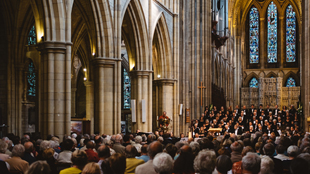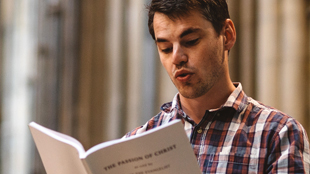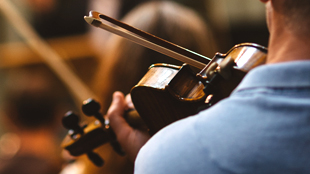Bach: Mass in B Minor
Tuesday 28th November, 2017
Bach’s Mass in B Minor – An introduction by Christopher Gray
Few composers in the first half of the 18th century were as conscious of their musical legacy as J S Bach. Composing was, at that time, a functional occupation, not the more arty, romantic pastime it became in the 19th century (no time to wait for anything as flowery as inspiration – a fresh cantata was required every Sunday!). Having spent his life studying the best music he could lay his hands on – from Vivaldi and Palestrina in Italy to Couperin in France and Schütz and Buxtehude in his native Germany – Bach had honed probably the finest compositional technique there has ever been. He had the tools to express not only a narrative through music, but also complex human emotions and abstruse concepts of philosophy and theology.
I think it is fair to say that Bach was realistic about his own gifts and achievements. Having studied (and, indeed, copied out by hand) so much of the greatest music he could find, he must have had the objectivity to know the relative quality of his own work.
The best guess of music scholars is that this appreciation of his own skill was the reason Bach completed several huge and impractical projects in the final years of his life – the Musical Offering, the Art of Fugue, Clavierübung III, and the Mass in B Minor. They were vehicles for Bach to leave a calling card to posterity.
With that in mind, the Mass in B Minor is, in one sense, a record of what Bach could do. He worked on the two-hour mass setting in 1748/49, before his death in 1750, incorporating and reworking material from the previous 25 years and also some new sections. The stylistic scope is broad: at times, he uses techniques that were, by the 1740s, outdated (the Palestrina-style counterpoint of the Gratias and Dona Nobis Pacem; and the incorporation of ancient plainsong melodies to root the Credo and Confiteor in the traditions of the church); but he also uses up-to-the-minute modern techniques that might have been more at home on an opera stage than in a church (the soprano soloists’ Christe Eleison has all the hallmarks of a love duet, for instance). In a nutshell, the Mass in B Minor can be seen as a compendium containing the very pinnacle of what Bach had achieved, and many would say the very pinnacle of what Western music has achieved.
If this theory is correct, then Bach’s choice of the Mass to convey his legacy is itself inspired. The Lutheran Church used sections of the mass in its services from time to time (for instance, the B Minor Mass Sanctus was performed in Leipzig on Christmas Day 1724). The Catholic Church, of course, regularly uses the whole mass (Kyrie, Gloria, Credo, Sanctus, Benedictus and Agnus Dei). Bach would have seen the church as being as immutable as God himself, so if he wanted to ensure the relevance of his legacy for all time, this would have been the text to set. And setting it in Latin (rather than German) ensured it was not tied only to Germany – it could enjoy an international relevance, unhindered by native language.
This is the tip of a fascinating iceberg and I must stop myself here before getting carried away. All I can do is implore you to come and hear this masterpiece. For us, the difficulty of the music is balanced by the choir knowing it well (most of our singers have done it before, at least once) and the privilege we all feel in being able to rehearse and perform music of such transcendent depth.



